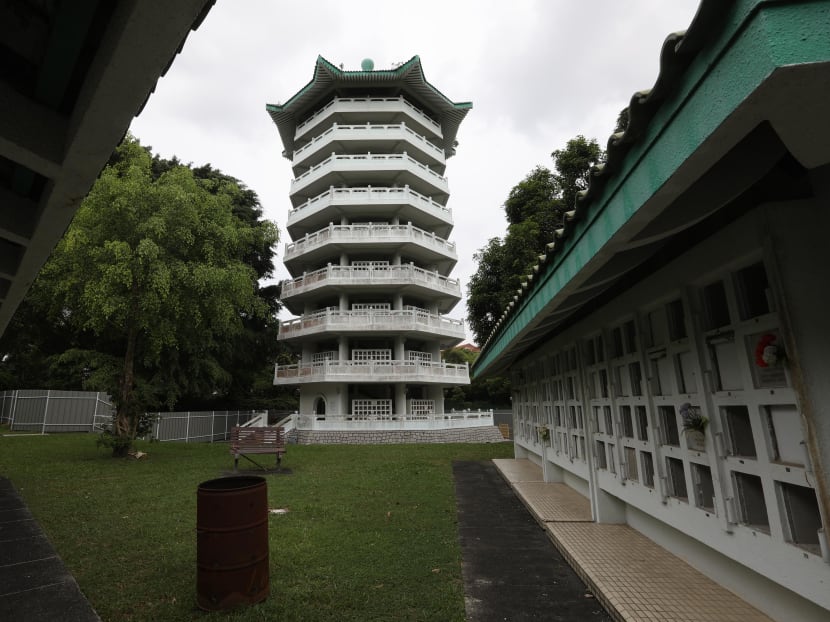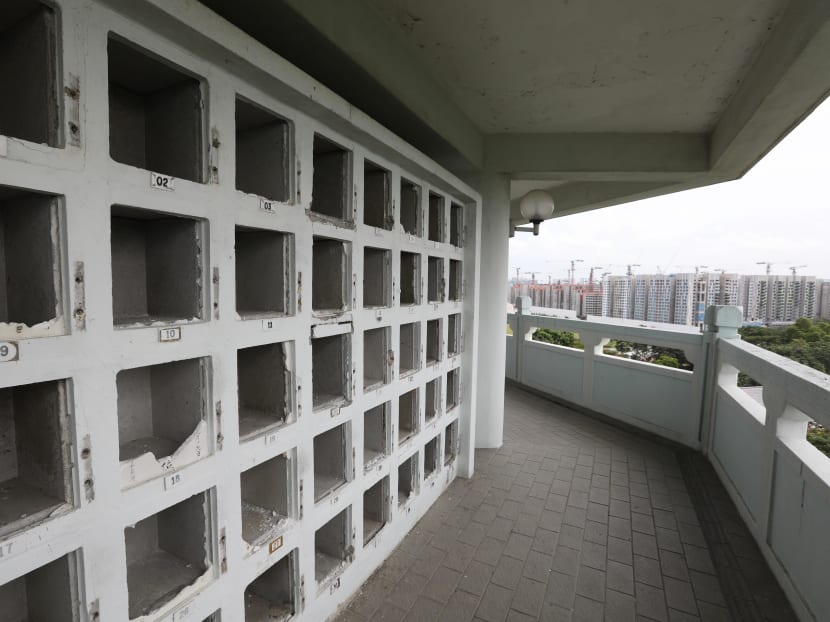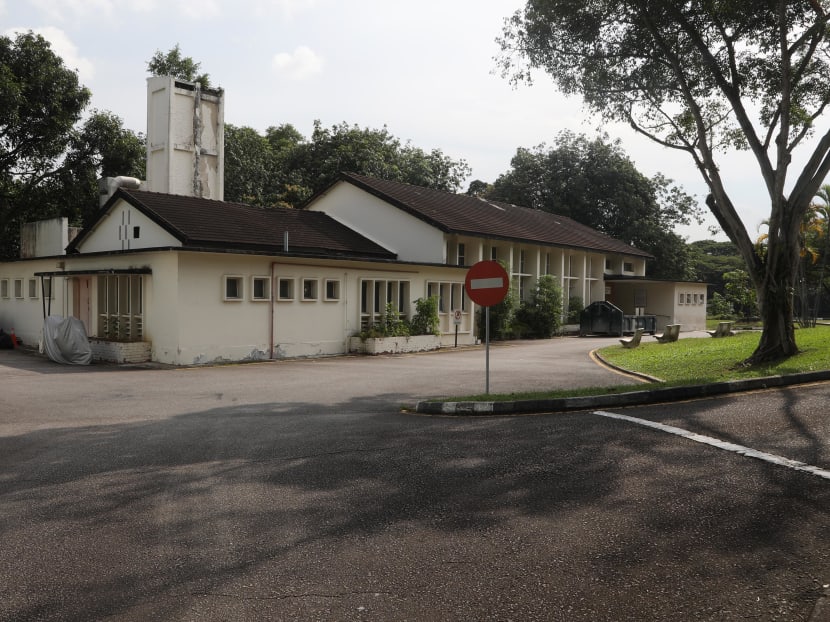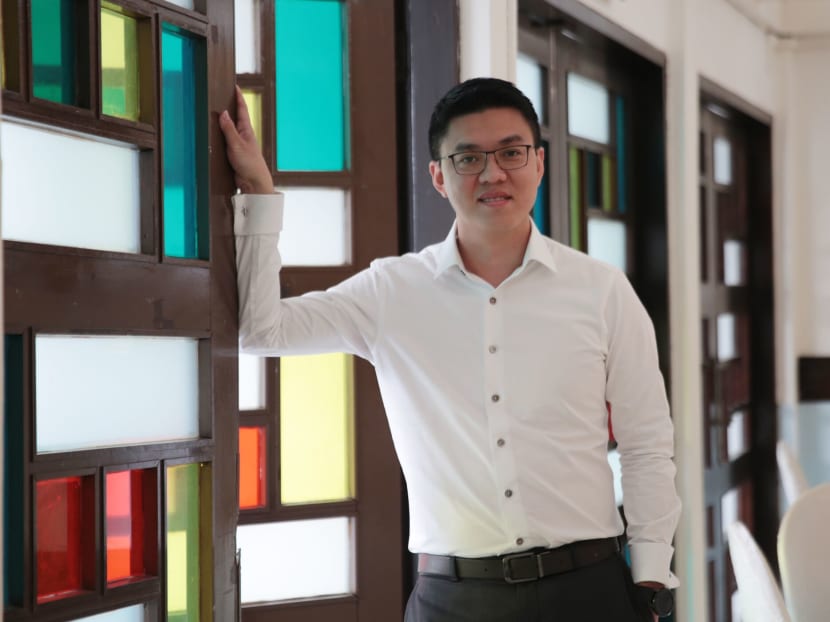The Big Read: In memoriam — Mount Vernon, a sanctuary which provided both comfort and chills
SINGAPORE — Joggers pick up their pace around it. Playful Maris Stella boys challenge each other to a night walk on its grounds or hide in it to escape from the 2.4km fitness runs. Thrill-seekers make ghost-hunting trips there to investigate reports of paranormal activity. Welcome to the strange world of Mount Vernon Columbarium, which offers its visitors both the comfort and the chills.

Mount Vernon Columbarium will be closed to the public in three weeks, putting an end to its illustrious 56-year run as a vanguard of the death services industry.
SINGAPORE — Joggers pick up their pace around it. Playful Maris Stella boys challenge each other to a night walk on its grounds or hide in it to escape from the 2.4km fitness runs. Thrill-seekers make ghost-hunting trips there to investigate reports of paranormal activity.
For intrepid city explorers looking beyond its property as the resting place for some 20,000 of Singapore’s dead, it is the best-kept secret fringing the city centre, offering an oasis of peace with the freshest air and lushest greenery, where migratory birds stop over and grieving parties find solace amid nature.
Welcome to the strange world of Mount Vernon Columbarium, which offers its visitors both comfort and chills. The site of Singapore’s first state-run crematorium, the columbarium will be closed to the public by the end of this month, halting its illustrious 56-year run as a vanguard of the death services industry.
The 7.1-hectare area has become a shadow of its past as mass relocation works to either Mandai or Choa Chu Kang — underway since 2013 — reveal more cavities with each passing day. Today, what remains are the plaques of some 2,700 unclaimed niches, with some of the receptacles containing stalks of plastic flowers a few tones down from their original colours.
There are also the last few batches of niches which have been claimed, and are in the process of being relocated.

(Above) The Mount Vernon Columbarium is well-known for its "high-rise" columbarium in the shape of a pagoda. Photo: Raj Nadarajan/TODAY
In the columbarium’s heyday, Nanyang Technological University assistant professor Liew Kai Khiun, 45, remembers it as the place that popularised cremation and experimented with radical concepts such as a “high-rise” columbarium in the shape of a pagoda, which housed the ash remains of his four grandparents.
With caskets manually pushed into the furnace “like in an industrial kitchen”, he used to feel the intense heat emitting from it, which had the effect of eliciting louder wails among his relatives.
Watching the smoke rising from its chimneys up to the heavens also gave mourners a form of closure to the passing of their loved ones.
As for the columbarium’s creepy side, the communication studies academic maintains that he would never take the pagoda’s lift to avoid a situation that would require him to use the corded emergency telephone inside — for fear that it would connect him to the underworld.
Spooky tales like his abound. Undertakers say they have heard stories about a white ghostly figure that would regularly appear on the seventh storey of the pagoda at 7pm, and a “resident” female ghost living between the two hexagonal-shaped funeral parlours in the compound.
Among netizens, particularly fans of a local YouTube series called “Ghost Watch”, Mount Vernon was said to be haunted with the souls of individuals who apparently committed suicide by jumping off the top of its pagoda, among other unverified stories.
Such tales had prompted its host, Mr Noel Boyd, to check out the place in an overnight “paranormal investigation” last year.
The resultant video footage went viral, featuring a dead pigeon without a head on the highest floor of the pagoda and “non-stop” unusual activity when Mr Boyd entered one of the defunct crematoriums and picked up a bone fragment from one of its long-decommissioned furnaces. The latter act spooked the 40-year-old emcee to the point of him suffering nightmares and sleepless nights for nearly a month, although he had emerged unscathed from more “eventful” trips to Pulau Ubin and Labrador Park.
Mr Boyd told TODAY that Mount Vernon Columbarium is “charged with negative energy” as it is where Singapore’s most notorious criminals, including Adrian Lim who murdered two young children in 1981, were also cremated.

(Above) Mr Noel Boyd, the host of a local YouTube series “Ghost Watch”, said the Mount Vernon Columbarium is “charged with negative energy”. Photo: Jason Quah/TODAY
A 'LIFE-CHANGING' PLACE
While such spooky tales and ghostly rumours are rife, Mr Kejenthiran Veeramuthu who works as a facility officer at Mount Vernon Sanctuary — one of the two funeral parlour companies operating out of the premises — found that there are “really no ghosts, spirits or what, only loved ones here”.
On his first day of work in 2013, however, the 44-year-old had goosebumps while walking the “eerie” path up the slope from the bus stop to report to work. So for three days, even though he reached the place at 6.30am, he would stay put at the bus stop until it got brighter before making his way to his workplace.
But as the days passed, he realised that it was “an island” removed from the stresses of city-living, and loved the surroundings so much so that he would arrive as early as 5am to “meditate” even though he only had to report to work at 8am.
No piling noise from the nearby Housing and Development Board (HDB) developments in Bidadari could be heard that early, and all around, he was surrounded by the sound of birds singing and the sight of squirrels roaming free on the compound’s empty roads.
The place also holds personal significance in Mr Kejethiran’s journey away from drugs, having been escorted there twice as a prisoner to send off his father in 1995, and his mother in 2002, and later, finding meaningful employment in the same building.
Even before he found a job at the compound, he was already attached to the place, heading there during his free time, taking a 40-minute bus ride from his flat at Bukit Merah to experience the peace whenever he felt down.
“This place (marks) my transformation… I feel sad that it will go, but what to do? Hopefully this is just a pause, and I look forward to coming back here to work,” Mr Kejenthiran told TODAY, citing his hope that Mount Vernon Sanctuary would win a tender at the replacement funeral parlour complex, also at Bidadari, which is expected to be operational in 2024 on a plot one-seventh the size of the current site.

(Above) Facility officer Kejenthiran Veeramuthu will go to work as early as 5am to "meditate" because he loves the peaceful surroundings. Photo: Raj Nadarajan/TODAY
In the meantime, it is not just the dead who have to find a new home.
Much of the wildlife — including the hornbills and owls frequently spotted by workers there — will be affected with the redevelopment of the area.
The Nature Society Singapore (NSS) vice president Ho Hua Chew noted that the area is a breeding ground for the nationally endangered spotted wood owls.
Based on NSS’ records in 2012, at least 141 species of birds roam the area, or about 38 per cent of the total number of birds recorded for the whole island. At least 59 of the species are migratory.
In 2013, NSS proposed that the Government retain 10 hectares of the former Bidadari woodlands as a nature park for wildlife and recreation. In the end, the authorities decided to retain approximately 1 ha of woodland.
"The impact on the wildlife is severe,” said Dr Ho, who estimated that only about half of the non-migratory species will survive.
The numbers will dwindle further when the HDB blocks are built, he noted. The migratory birds will be most affected, he said, adding that the area was an important "refuelling station" on these birds’ long migratory journey.
.embed-container { position: relative; padding-bottom: 56.25%; height: 0; overflow: hidden; max-width: 100%; } .embed-container iframe, .embed-container object, .embed-container embed { position: absolute; top: 0; left: 0; width: 100%; height: 100%; }
FROM DIRT TO HIGH-RISE LIVING
Built in 1962 when burials were still more popular, the first state-run crematorium existed as a forgotten counterpart alongside the Bidadari cemetery, operating with one funeral service hall that hosted only four cremations a week on average.
It only started growing in popularity 10 years later when then Minister for the Environment Lim Kim San made clear that cemeteries in and around the city would be closed “to conserve land, particularly in the urban areas”, as he pointed to cremation as “the long-term solution”.
Four years after Bidadari cemetery put to rest its final dead in 1972 along with the closure of other cemeteries, the crematorium grew to accommodate its own columbarium, starting with 3,000 niche slots organised in 15 roofless low-lying blocks. This cost the Government about S$220,000. At that time, each niche went at S$300, while burials were two to three times the cost.
Over the next 10 years, the public columbarium at Mount Vernon grew to hold more than 10,000 niches built in a similar orientation, with a design upgrade of green-tiled roofs.
In 1987, the area got the distinctive landmark it is now known for – a nine-storey, Chinese-style pagoda in which niche blocks were oriented in a hexagonal shape as one solution to a space crunch. Along with a two-storey “church-style” building built beside it, the two “high-rise” columbariums collectively more than doubled the number of niche lots at Mount Vernon to offer 13,230 more niches.
The idea of the pagoda was so “modern” that when he placed his grandparents’ niches on the second and third storeys of the pagoda, his family members joked that “even the dead have to start living in high-rise flats” due to the scarcity of land, said Asst Prof Liew.

(Above) Emptied niches seen from the columbarium in the shape of a pagoda at Mount Vernon Columbarium Complex. Photo: Raj Nadarajan/TODAY
While the idea started out being foreign to Chinese customs, it later took on a life of its own. Singapore Casket assistant general manager Calvin Tang told TODAY some people started developing beliefs that a high niche placement is more favourable as the spirits of their loved ones can “start off being closer to heaven” and “bless descendants from (their vantage points)” to take on “high-ranking positions”.
“Just like how Singaporeans took some time to adjust themselves from living in kampungs to living in pigeonhole-like HDB flats, it was the same with the pagoda,” added Mr Tang, 42.
As in real estate pricing, even the view a property brings and the direction it faces matter, said Mr Tang, noting that some private columbariums charge more for niches in certain sections of their grounds because of the better view they offer the dead.
VANGUARD OF THE FUNERAL INDUSTRY
As with its experimental pagoda columbarium that appears to have not been replicated elsewhere, and its pioneering cremation practices, Mount Vernon Columbarium had always been well ahead of its time in Singapore. In recent years, it has been fronting progress on another end.
Never mind that it got decommissioned in 2004 when Mandai Crematorium took over its function. Six years later, the columbarium got a new lease of life by focusing on another aspect of death services that was in dire need of a transformation in Singapore: Funeral parlours.
This time, it was not the Government blowing life into the pagoda grounds space, but one of Singapore’s oldest undertakers, Ang Chin Moh Funeral Directors, which invested at least S$1 million over five years in the termite-infested buildings of two of Mount Vernon’s crematorium halls.
The result was six “six-star” funeral halls of various sizes that became so popular that a handful of families had delayed the wakes of their loved ones to ensure that they could hold their funerals there.
Their bright and clean “chapel-style” halls nestled in nature were a breath of fresh air, filling a void in the market that was previously saturated with makeshift funeral parlours at HDB void decks or drab-looking spaces in industrial estates at Sin Ming Drive or Ubi Road 4.

(Above) A disused funeral hall in Mount Vernon now used as a site office for the claiming of remains from the columbarium. Photo: Raj Nadarajan/TODAY
Lamenting that Singapore is a first-world country with a third-world death services sector, the brains behind the Mount Vernon Sanctuary project, Ang Chin Moh Group deputy chairman Ang Ziqian, saw the government tender as a rare opportunity to disrupt the funeral profession to “up its standards”.
Noting that the industry’s “dog in the manger attitude” was doing itself a disservice, especially as the industry had always had to grapple with short-term leases, the 36-year-old, fourth-generation funeral director leased out his halls to other funeral directors, showing that they could “share to win, and win to share” so as to even the playing field for everyone.
Shortly after Mount Vernon Sanctuary opened its doors, he started noticing other parlours at Sin Ming Drive renovating their places. That to him was his success.
Although he is uncertain if he would get back a place at his subsidiary company’s namesake location in 2024, Mr Ang said his next ideal locations would not be “in the far-flung places”, but spread in the north, south, east, west and central of Singapore to serve every community.
This is in line with his strong belief that a person’s death or a funeral can help to foster social and family cohesion in a society, and members of a community should not be discouraged from attending someone’s wake because of the distance or inconvenience.
“Humans do not only have economic value, and once your value is used up, you dispose it like a trash. I think that’s not right,” he added. “My plan is always to get another location so that Singaporeans who lose their loved ones continue to have a place that is dignified enough to celebrate the lives of their loved ones. It is a place you bring families together, create love, affection and bond.”

Singapore Casket operates two other parlours in the Mount Vernon complex. Along with Mount Vernon Sanctuary's six halls, the eight funeral halls at Mount Vernon currently constituted close to a fifth of Singapore’s publicly available funeral parlours. The 34 other halls are along Sin Ming Drive (13), the Singapore Casket building at Lavender Street (12), Teochew Funeral Parlour in Ubi (6), Geylang Bahru (2) and at Toa Payoh Industrial Hub (1).
The new Mount Vernon complex will house 12 wake halls. It is unclear whether the Government plans to tender it out, or lease out the halls directly.
HIGH-PROFILE SEND-OFFS
For Singapore Casket, Mount Vernon was where they organised the largest-scale funeral the firm had ever held in its history – the wake of the late Liem Sioe Liong, once Indonesia’s richest man, who died from natural causes a month before his 96th birthday on June 10, 2012.
The funeral of Liem — who had a net worth of US$3 billion in 1994, when he was named the richest ethnic Chinese in South-east Asia by Asiaweek magazine — was attended by more than 1,000 guests, including former Indonesian president Megawati Sukarnoputri and several Singaporean ministers.
Both Singapore Casket’s parlours were combined in the multi-million-dollar week-long funeral affair that saw an air-conditioned tent erected, buggies from Bintan deployed, as well as valet parking and massage services offered, according to Singapore Casket’s Mr Tang.
Also, more than S$1 million was spent on food catering alone, he added, pointing out that lobsters were in the menu. “It was a celebration of a life,” he said.
Over at Mount Vernon Sanctuary, one of their biggest was the funeral of former Hong Kong actress Jacqueline Law, who died at the age of 45 due to pancreatic cancer. Paparazzis from overseas flooded the carparks of Mount Vernon, craning to catch photos of her guests that included Hong Kong celebrities such as Ekin Cheng and Monica Chan Fat-Yung.
MOVING ON
If anything, the Mount Vernon Columbarium niche relocation showed that finding a permanent site for the dead could be difficult in a land-scarce island.
Correspondingly, Singapore Casket’s Mr Tang said the number of sea burial ceremonies is on the rise as “throwing ashes into the sea” gains acceptance among Buddhists and Christians, while Hindus have traditionally used the method.
Some 20 to 30 years ago, Singapore Casket used to handle only 10 to 15 cases of sea burial a year, but now it has risen to 15 to 17 cases a month.
He said that one of the reasons is that the deceased want to spare their descendants from the hassle of having to relocate their remains elsewhere in the future. It is also more affordable than getting a niche.
A biodegradable container for a sea burial costs S$340, he said. As for a columbarium, without even factoring in the price to secure a niche, an urn starts from S$180, and a marble slab costs about S$1,500.
In Mr Tang’s talks with some elderly folks on pre-planning their funeral, the issue of a columbarium's “lease” for the dead often popped up.
An increasingly popular belief is that sea burial is better since “their grandchildren would only pay their respects (half) the time, and great-grandchildren won’t bother”, said Mr Tang. “They don’t want to be left behind alone.”
For events management company director Alvin Oon, the recent relocation of his grandmother’s remains to St Anne’s Church in Sengkang from Mount Vernon had the 51-year-old thinking about the inevitable “cycle of life”.
“Most Singaporeans accept moving to be part of life in Singapore because there is no land,” said Mr Oon, adding that the redevelopment was “expected” as the columbarium sits on prime land.
“It is a human thing. It is a cycle of life. We need to move on,” he said.
THOUSANDS OF NICHES UNCLAIMED
About 2,700 niches at Mount Vernon Columbarium remained unclaimed as at the end of August, and the ashes will be scattered at sea if they are not claimed over the next three years, the National Environment Agency (NEA) said in response to TODAY’s queries.
The columbarium will be closed to public by the end of this month, and unclaimed niches will be moved to Mandai Columbarium for storage.
The claim and registration exercise for the relocation of the 20,000 niches at the columbarium had started on Oct 28, 2015. Registration closed on June 30, 2017.
Of the more than 17,000 niches which have been claimed, 85 per cent of the claimants have opted for their loved ones to be relocated to a government columbarium at either Mandai or Choa Chu Kang. Eleven per cent chose to move the niches to private columbaria, while the remaining 4 per cent opted to scatter the ashes at sea.
The option to move a niche to a government columbarium is free, with the government covering the costs of niche installation, providing a standard niche marble plaque and a replacement urn if the original one was damaged during relocation. The relocation is being done in batches.
The mass relocation followed the Housing and Development Board’s announcement in 2013 that the Mount Vernon Columbarium will be cleared to make way for housing developments in the Bidadari estate.











